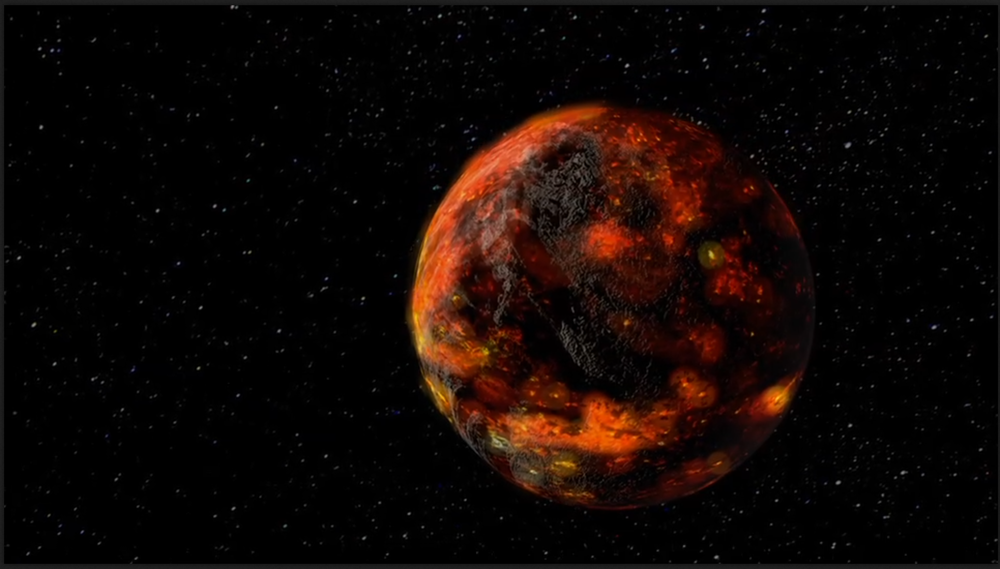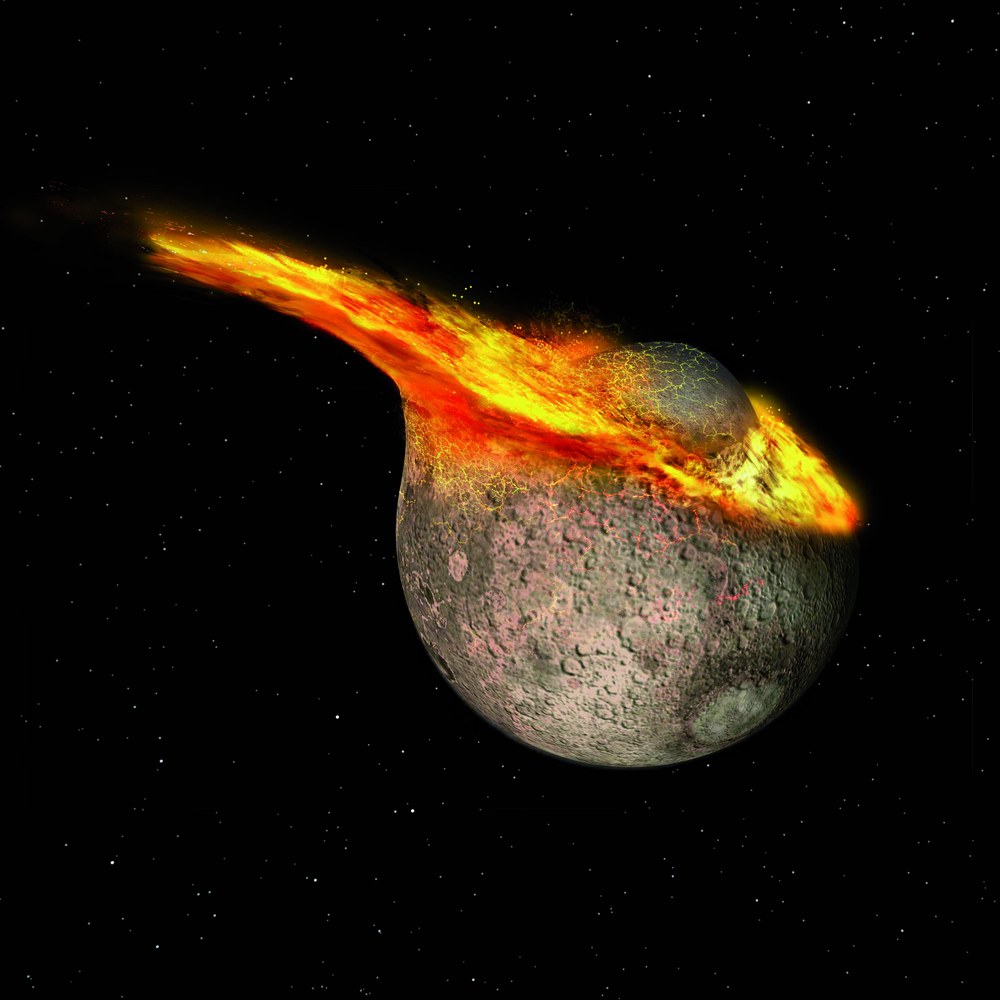A slightly younger Moon



- Earth's natural satellite was formed from debris created by a collision between the young Earth and a protoplanet.
- During this process, the Moon heated up so much that a magma ocean over 1000 kilometres deep formed, which then took up to 200 million years to solidify.
- Using a new numerical model, scientists from DLR and the University of Münster have been able to link these events with the time of the Moon's formation.
- They found that the Moon formed 4.425 billion years ago, almost 100 million years later than previously thought.
- Focus: Planetary research, planetary geophysics, modelling, space
The Moon formed a little later than previously assumed. When a Mars-sized protoplanet was destroyed in a collision with the young Earth, a new body was created from the debris ejected during this catastrophe – the Moon. Planetary geophysicists at the German Aerospace Center (Deutsches Zentrum für Luft- und Raumfahrt; DLR), led by Maxime Maurice, together with researchers at the University of Münster have used a new numerical model to reconstruct the time at which the event occurred – 4.425 billion years ago. The previous assumptions about the formation of the Moon were based on an age of 4.51 billion years – that, is 85 million years earlier than the new calculations reveal. The scientists report on this today in the scientific journal Science Advances.
Four-and-a-half billion years ago, the Solar System was still a rather chaotic place. Earth was still growing to its present size, collecting matter in the form of what are referred to as ‘planetesimals’. These had previously formed in the disc of dust and gas orbiting the early Sun. The young Earth consolidated, becoming ever hotter inside. Increasingly large parts of the rocky mantle melted and formed a magma ocean. It is at this time that Earth gained the natural satellite that continues to orbit around it to this day. A massive cosmic collision between Earth and a protoplanet resulted in rock being ejected from the young Earth. Eventually, this debris agglomerated to form a new planetary body – the Moon.
In principle, most scientists agree about how the Moon formed, but not about the details of the process and especially not about the time at which it occurred. "The results of our latest modelling suggest that the young Earth was hit by a protoplanet some 140 million years after the birth of the Solar System 4.567 billion years ago," says Maxime Maurice, summarising the team's investigations. "According to our calculations, this happened 4.425 billion years ago – with an uncertainty of 25 million years – and the Moon was born."
At that time, Earth had just developed into a planet. During this development, the heavy, metallic components sank to its centre and formed a core of iron and nickel, which was surrounded by a thick mantle of silicate rocks. The mantle rocks became hotter and hotter due to the process of 'accretion' – the agglomeration of matter – and through heat from the decay of radioactive elements. This allowed the separation of metals and silicates to take place in Earth's interior within a few tens of millions of years.
A planetary bullseye caused the formation of the Moon
At this stage, Earth was hit by Theia, a protoplanet that was perhaps the size of Mars. Theia was one of the Titans in Greek mythology, and the mother of the Moon goddess Selene. In the early days of the Solar System, there would have been many bodies of this kind. Some were ejected from the Solar System, while others were destroyed by collisions with other bodies. Theia, however, hit Earth and caused the ejection of such a large amount of material from the planet’s mantle that the Moon was able to form from it. During this violent impact, a several thousand kilometre deep magma ocean of glowing hot, molten rock formed. Today, no traces of Theia remain following this collision.
Reconstructing how the formation of the Moon was triggered by this event requires a great deal of imagination and creativity. The collision of the two bodies, with its enormous energy, also vaporised a large amount of rock from Earth's early mantle. This was ejected and collected in a ring of dust around Earth before it reassembled there to form rock. "From this, the Moon was formed in a short time, probably in just a few thousand years," explains Doris Breuer, Head of the Planetary Physics Department at the DLR Institute of Planetary Research and a co-author of the study.
The oldest Moon rock is not old enough
Scientists largely agree about the history of the Moon's formation. However, they have not been able to date it exactly, as none of the Moon rocks brought to Earth by the astronauts of the six Apollo missions and the three Soviet Luna robotic missions directly record the age of Earth's natural satellite. Researchers from DLR and the University of Münster have determined when the Moon was formed using a new, indirect method. "Our calculations show that this most likely happened at the very end of Earth's formation," says Sabrina Schwinger, another co-author of the study, describing the chronological sequence of events.
It was not only Earth that had an ocean of magma in its early youth. Energy gained from accretion also led to the formation of a magma ocean on the Moon. The Moon melted almost completely and, similarly to Earth, was covered by a magma ocean over 1000 kilometres deep. This magma ocean quickly began to solidify and formed a crust of floating, lightweight crystals at the surface – its 'interface' with the cold space. But under this insulating crust, which slowed down the further cooling and solidification of the magma ocean, the Moon remained molten for a long time. Until now, scientists were unable to determine how long it took for the magma ocean to crystallise completely, which is why they could not conclude when the Moon originally formed.
To calculate the lifetime of the Moon’s magma ocean, the scientists used a new computer model, which for the first time comprehensively considered the processes involved in the solidification of the magma. “The results from the model show that the Moon’s magma ocean was long-lived and took almost 200 million years to completely solidify into mantle rock,” says Maxime Maurice. “The time scale is much longer than calculated in previous studies,” adds DLR colleague Nicola Tosi, second author of the study and advisor of Maxime Maurice’s PhD thesis, which was the base for this condensed scientific report. “Older models gave a solidification period of only 35 million years.”
Solidification models reveal the age of the Moon and Earth
To determine the age of the Moon, the scientists had to go one step further. They calculated how the composition of the magnesium- and iron-rich silicate minerals that formed during the solidification of the magma ocean changed over time. The researchers discovered a drastic change in the composition of the remaining magma ocean as solidification progressed. This finding is significant because it allowed the authors to link the formation of different types of rock on the Moon to a certain stage in the evolution of its magma ocean. “By comparing the measured composition of the Moon’s rocks with the predicted composition of the magma ocean from our model, we were able to trace the evolution of the ocean back to its starting point, the time at which the Moon was formed,” explains Sabrina Schwinger.
The results of the study show that the Moon was formed 4.425±0.025 billion years ago. The Moon’s exact age is in remarkable agreement with an age previously determined for the formation of Earth’s metallic core with the uranium-lead method, the point at which the formation of planet Earth was completed. “This is the first time that the age of the Moon can be directly linked to an event that occurred at the very end of the Earth's formation, namely the formation of the core,” says Thorsten Kleine from the Institute of Planetology at the University of Münster.
Funding:
The work was carried out within the framework of the Transregional Collaborative Research Center TRR 170 'Late Accretion on Terrestrial Planets' and the Helmholtz Young Investigators Group 'Early dynamics of the terrestrial planets' and was funded by the German Research Foundation and the Helmholtz Association of German Research Centres.
Original publication:
M. Maurice, N. Tosi, S. Schwinger, D. Breuer, T. Kleine (2020). A long-lived magma ocean on a young Moon. Science Advances; DOI: LINK
